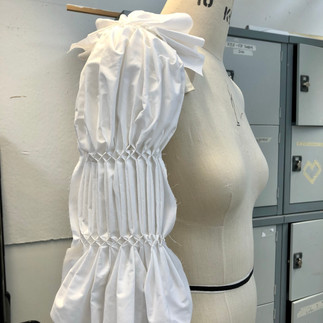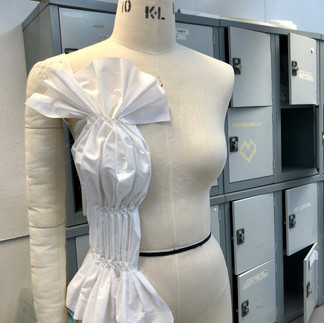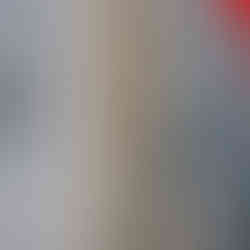12th April 2021
- Hannah G

- May 4, 2021
- 3 min read
Updated: May 24, 2021
Design
After doing stand work with some of my first samples I saw how one of the samples could be an entire bodice piece going from front to back, making an attached sleeve shape. So, I trailed this out by making t again on a larger piece of fabric. The sleeve shape sat well on the body and the top row of smocking was effective, however the size of the bottom two rows were too narrow and deep so used a lot of fabric to make a tiny section of fabric. Because it was deep this also added bulk to the waist which isn’t flattering or comfortable. Therefore, I made it again but this time making the smocking the same size above and below the breast point. I also experimented with creating a whole bodice from one piece of fabric after doing some research of contemporary smocked garments which have a slashed neck and grown on sleeves. The full bodice idea wasn’t perfect as I made the smocking the same distance from the neck both front and back. This meant the back smocking was too high up and didn’t match the front smocking at the side seam. Therefore, if I did it again, I need to measure the position of the smocking on the mannequin. The half bodice created from this sample was more successful and made a similar grown on sleeve shape to the previous sample. Next, I’m going t try making a longer sleeve shape similar to the contemporary garments I researched. I could also try this idea out with shirring techniques.
Research
From my research of the Liberty and Co blouse I have developed samples. At first, I was looking at honeycomb smocking and how the fabric reacted to where I smocked it. If I kept the smocking in line with the row below it created pleats like the blouse. If I made them out of line it would create a voluminous curved shape. But they took a very long time to make, with one sample taking a whole day. This would be unachievable for me to do for a whole garment. Furthermore, if it were for industry and a commercial business this wouldn’t be possible. But I want to see how this technique could be done quicker but not lose the craft, quality and attention to detail I want to achieve.
For the next samples, I increased the size of the design and used lighter fabric. The first sample was difficult to sew as the cotton was too thick. The liberty blouse is made from silk which is a lightweight fabric so therefore I used a fabric more like this (lightweight calico). These were a lot quicker to make, taking only about 45mins each. I still like the density of the first sample but perhaps I could use a combination of bigger and smaller smocking on a garment to decrease the production time.
Another way I could shape the fabric is with shirring, this technique uses a machine to stitch elastic thread that then gathers the fabric. Rather than just shirring in rows which is seen a lot on high street garments, I wanted to see how I could create more interesting shapes that take more skill and thought to produce. This links to a quote I found a part of my research which states ‘It is not craft as ‘handcraft’ that defines contemporary craftsmanship: it is craft as knowledge that empowers a maker to take charge of technology’ (Dormer 1997). I continued with manipulating the fabric in straight lines and placing it on the stand to create sleeve shapes like the Liberty blouse. I really liked the more unusual tulle/organza fabric as it helped the samples look more modern and interesting.
Reflecting on my previous smocking stand work I felt the placement of the samples, particularly the sleeves, looked a bit too costume like and not contemporary. Therefore, I thought about enlarging the more successful samples and see if I could keep some historical elements but with softer modern shapes. The first one I did wasn’t successful as I covered the whole piece smocking, so it was more of a fabric texture than garment construction method.
Therefore, I created another one with a more linear design. The silhouettes it created were successful as they had a soft shape but still synched in at flattering parts of the body. This is like the 1890s blouse and the fluid dresses seen in Pre-Raphaelite paintings, which strongly influenced the aesthetic movement. Going forward I would like to try enlarging some more smocking samples.




































Comments